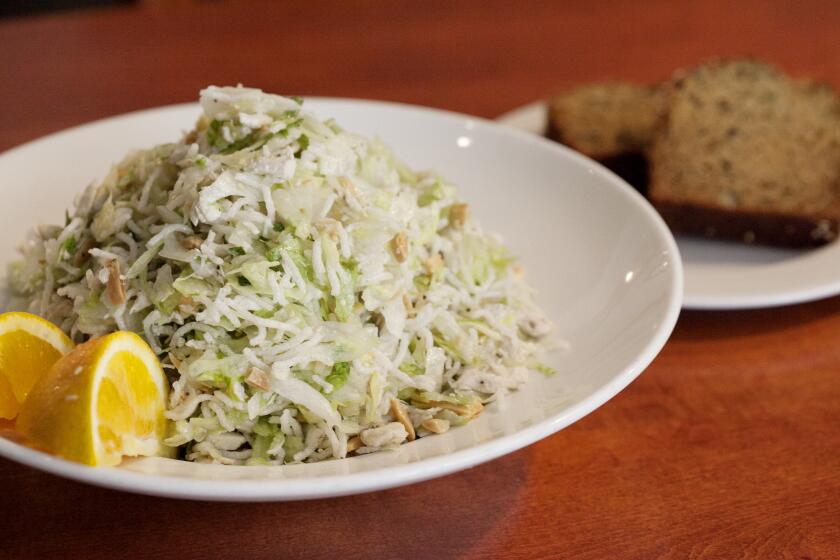An Herbal Companion
- Share via
African Basil: A cross between camphor and opal basils, it has very pungent but beautiful purple-veined leaves. Perennial.
Borage: Distinguished by its beautiful blue star-shaped blossoms, borage is classified as a hardy annual and can sprawl over a four-square-foot area. The flowers and very young leaves are commonly used in salad. The flavor is most frequently compared to cucumbers.
Buffalo Grass: This is an unassuming ornamental-looking grass that shows no flavor or smell unless it is dried or treated. When soaked in alcohol, it yields a hay-like odor.
Cuban Oregano: Actually a close relative of Swedish ivy, this fuzzy, thick-leafed plant looks more succulent than herb, but has an intense oregano smell.
Epazote: This leggy plant is an annual, but will volunteer with abandon. It has a pungent flavor that is regarded as indispensable to bean dishes in Mexico.
Kaffir Lime Leaves: Intensely aromatic leaves that grow in pairs on a stem. The flavor is bright, without the tang of citrus. Kaffir lime trees grow well in Southern California.
Pak Chee Farang: This plant produces slim leaves about five inches long with serrated edges. The flavor is somewhat like cilantro, but more intense.
Rau Ram (Laksa Leaf): Narrow, pointed leaves with a powerful, peppery taste characterize this herb. Once planted, it grows profusely.
Horapha (Red-Stemmed Basil): This strongly anise-flavored basil is the one used in Southeast Asian cooking. Regular sweet basil can take its place.
Salad Burnet: A bushy perennial growing 12 to 24 inches tall, with fern-like foliage that tastes and smells of cucumbers.
Shiso Leaf: Perilla and beefsteak leaf are other names for shiso , which comes in three varieties: purplish-red, green and a combination of the two. The graceful leaves have a pungent, edgy taste.
Spice Basil: A cross between common garden basil and wild basil, the taste of the wide green leaves is on the camphory side.
Bai Kaprao (Thai Holy Basil): Hard to find and fragile, this herb is stir-fried and even deep-fried in Thai cookery. Mint and regular basil are used as substitutes here.
Maenglak (Thai Lemony Basil): Another of the many varieties of basil that grow here, this one has a slightly tangy taste. The Thais call it maenglak.
Nepetella (Wild Mint): A member of the Nepeta (catmint) family, this is a stalky, low-grower that tends to sprawl, especially after its first full year of growth. The smell is minty, vaguely like pennyroyal, though Italian food authority Giuliano Bugialli describes it as a cross between sage and rosemary. It is regarded as an essential companion to fresh porcini.
More to Read
Eat your way across L.A.
Get our weekly Tasting Notes newsletter for reviews, news and more.
You may occasionally receive promotional content from the Los Angeles Times.











